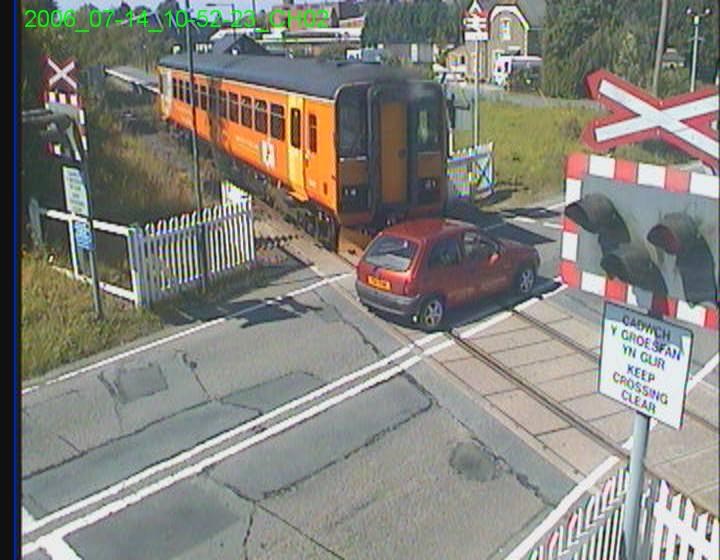Thursday 25 Jun 2009
WOULD IT KILL YOU TO WAIT? (llanelli)
- Region & Route:
- | Wales & Western: Wales & Borders
- | Wales & Western
HARD HITTING LEVEL CROSSING SAFETY MESSAGE DRIVEN ACROSS EUROPE
Network Rail today raises awareness of level crossing misuse at one of South Wales' most misused public crossing -Llanelli East, Station Road – in support of a European level crossing day of action. The Don’t Run the Risk awareness day will see activities take place across 23 countries and nine most misused level crossings in Britain.
Its dedicated team of Community Safety Managers will be handing out leaflets that spell out the chilling truth that taking a chance at a level crossing might be the last thing you do, and pose the question: ‘would it kill you to wait?’
The awareness day, which aims to combat level crossing misuse and highlight the dangers of ignoring warning signs and barriers has been supported by road and rail sector organisations including the British Transport Police, Arriva Trains Wales and government agencies across Europe.
Llanelli East is the busiest level crossing in South Wales, with approximately 8000 users a day and a shockingly high number of incidents of misuse. Based on recent records, there were as many as 100 incidents of occurring in a short space of one week and these incidents included vehicles jumping red lights, swerving around barriers and pedestrians trespassing from the crossing onto the platform.
Over 600 people die at level crossings across Europe each year. Across Wales, there were more than 400 level crossings incidents recorded last year and nearly 30 near-misses, where trains narrowly avoided hitting motorists.
Whilst even one fatality is too many, the latest European fatality statistics (2008)* reveal Germany, France, The Netherlands and Spain have all tragically seen higher levels than Britain.
European Country/Total number of persons killed by level-crossing accidents in 2008
Hungary 118
Germany 52
Czech Republic 43
Romania 42
Poland 40
France 38
Latvia 27
Austria 25
The Netherlands 18
Spain 17
Portugal 17
Slovakia 17
Great Britain 15
Network Rail’s hard hitting level crossing safety campaign ‘Don’t Run the Risk’ is beginning to have an impact on people’s behaviour, according to research conducted for the company by Millward Brown.
An online survey this spring found:
- Before the recent advertising campaign (November-February) 55% said they understood what not to do at level crossings, post the campaign this rose to 67%.
- 54% of people said that the advert had already influenced their behaviour at level crossings.
- 67% said that it would influence their behaviour at level crossings in the future.
Alan Milne, community safety manager at Network Rail said: “Jumping the gates, swerving around barriers and ignoring warning signs is sadly a sight we see all too often, and in many cases with tragic outcomes. We’re out today at Llanelli where misuse is at its worst to try and hit home the message that running the risk at a level crossing is just not worth it. By trying to save a few seconds, you could end up losing your life.”
On the campaign research results, Mark Shaoul, head of marketing for Network Rail commented: “The impact we’ve had in driving recognition of the safety campaign with the recent bursts of activity has been phenomenal. We know that translating what people say they will do into real action will be the litmus test, but these results show us we are on the right track for helping to deliver. This, along with many other activities that the business is working on, will help to reduce level crossing incidents and needless injuries and deaths.”
Notes to editors
Last year, over 55 days of delays to trains and passengers were caused by level crossing misuse, costing Network Rail around £1.8million – money that could have been invested into the railway. The real cost to the industry far exceeds this, as it does not include actual damage to trains or tracks or staffing time and cost. Facts about level crossings - Level crossings are safe if used correctly - 95% of accidents at level crossings are caused by misuse or error– i.e. drivers ignoring red signals, barriers and klaxons - There are over 7,600 level crossings both on public and private land that cut across the UK railway network.Contact information
Passengers / community members
Network Rail national helpline
03457 11 41 41
Latest travel advice
Please visit National Rail Enquiries
Journalists
Network Rail press office -Western route
MediaRelationsWestern@networkrail.co.uk
About Network Rail
We own, operate and develop Britain's railway infrastructure; that's 20,000 miles of track, 30,000 bridges, tunnels and viaducts and the thousands of signals, level crossings and stations. We run 20 of the UK's largest stations while all the others, over 2,500, are run by the country's train operating companies.
Usually, there are almost five million journeys made in the UK and over 600 freight trains run on the network. People depend on Britain's railway for their daily commute, to visit friends and loved ones and to get them home safe every day. Our role is to deliver a safe and reliable railway, so we carefully manage and deliver thousands of projects every year that form part of the multi-billion pound Railway Upgrade Plan, to grow and expand the nation's railway network to respond to the tremendous growth and demand the railway has experienced - a doubling of passenger journeys over the past 20 years.
Follow us on Twitter: @networkrail
Visit our online newsroom: www.networkrailmediacentre.co.uk

